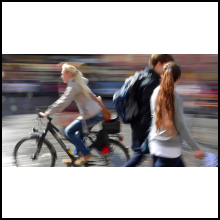
Research Webzine
Analysing video images to improve traffic safety
Professor Nicolas Saunier, Department of Civil, Geological and Mining Engineering
Smile! You’re on camera – at the intersection. But it’s in the name of science and traffic safety. Professor Nicolas Saunier sets up video cameras at sensitive locations in terms of road safety, like intersections, and analyses the footage taken to assess the risks of crashes.

Smile! You’re on camera – at the intersection. But it’s in the name of science and traffic safety.
Professor Nicolas Saunier sets up video cameras at sensitive locations in terms of road safety, like intersections, and analyses the footage taken to assess the risks of crashes.
With algorithms, he can automatically extract from the images various safety indicators, like the time just prior to the collision. That provides, in a given moment, the time that separates two users (drivers, pedestrians, bicyclists) from a crash if neither alters course. Taking into account the perception-reaction time of subjects, the shorter time to collision, the greater the risk of a crash. This method is used to compare findings before and after measures are implemented to improve traffic safety, in order to quantify the precise effect of these safety initiatives, assuming that all other conditions remain constant.
For instance, the researcher and his colleague Professor Luis Miranda-Moreno of McGill University, have conducted a study on bicycle lanes, painting spaces where cyclists can position themselves in front of cars at an intersection’s stop line.
“We noticed that the effect has been rather positive,” says Professor Saunier, “The number of infractions fell, particularly those that involved dangerous situations. The survey shows that when these measures are taken, bicyclists increase their safety margins with motor vehicles.”
The video analysis also estimates more precisely the time required to cross a street on foot. “We can judge what percentage of the population, like children or those who with reduced mobility, can be at risk from the time allowed to cross the street.”
What next? Drones – specifically images they can capture. “Our camera angles are quite weak in relation to the road, which can mask issues between users. A drone filming above an intersection provides us with a comprehensive view of the situation, without obstruction.”




